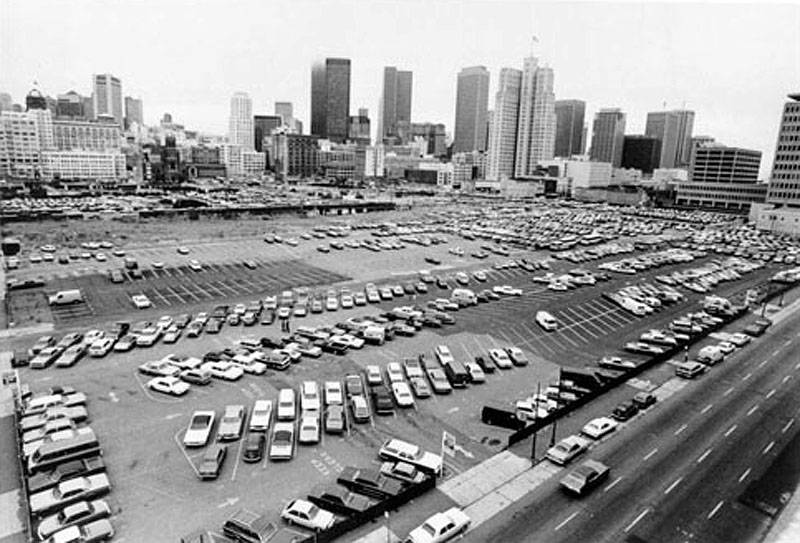Redevelopment and Patronage Politics: Difference between revisions
m (1 revision(s)) |
(added photo) |
||
| (6 intermediate revisions by 2 users not shown) | |||
| Line 1: | Line 1: | ||
'''<font face = Papyrus> <font color = maroon> <font size = 4>Historical Essay</font></font> </font>''' | |||
''by Chris Carlsson'' | |||
[[Image:1977 view of YBG lots AAC-0727.jpg]] | |||
'''Yerba Buena Center after clearance of hotels and when it was covered by parking lots, 1977.''' | |||
'' | ''Photo: San Francisco History Center, San Francisco Public Library'' | ||
based on Chester Hartman's The Transformation of San Francisco'' | Black union leaders from the ILWU and other San Francisco locals were given influential city appointments, especially in the Redevelopment Agency. Ultimately, certain black unionists became the bureaucrats overseeing the gutting of the black Western Addition. ILWU representative Wilbur Hamilton was appointed to the San Francisco Redevelopment Agency in 1968 and soon after got the job of project manager for the Western Addition A-2 project, the SFRA's largest neighborhood clearance plan. Hamilton gave a black , pro-labor face to the essentially white racist "slum clearance" plan devised in the boardrooms of downtown San Francisco. He was succeeded on the SFRA Board by another ILWU representative, Joe Mosley (Mosley resigned his job in 1976 when he was indicted by a federal grand jury for attempted extortion in connection with the Agency's Hunters Point project). Wilbur Hamilton, deputy director since 1974, became the Executive Director of the SFRA in 1977. | ||
An ILWU organizer, Rick Sorro, was appointed to Mayor George Moscone's Select Committee on Yerba Buena Center in March, 1976. The union alliance of the SF Building Trades Council, the SF Central Labor Council, and the Teamsters Joint Council had been actively pushing for the South of Market redevelopment project called [[LABOR & YERBA BUENA CENTER|Yerba Buena Center]], which was to include a new Convention Center. Ironically, this redevelopment plan came largely at the expense of retired longshoremen and other port workers who inhabited the old neighborhoods which were designated "blighted" in order to facilitate eminent domain clearance by the Redevelopment Agency. | |||
Leroy King is another ILWU official who became a Redevelopment Agency commissioner in 1981 under [[Mayor Dianne Feinstein|Dianne Feinstein]], where he fought for affirmative action efforts in minority subcontracting. He replaced the pastor of the First AME Zion Church of the Western Addition, Parree Porter, who had earlier assumed the role of black representation on the Redevelopment Commission when he replaced Wilbur Hamilton's in-law Hannibal Williams, who had resigned in 1978 after sniping at the other commissioners and calling them "white liberal zookeepers". | |||
''based on Chester Hartman's'' The Transformation of San Francisco, ''and John Mollenkopf's'' Contested City'' | |||
[[Fillmore Redevelopment|return to Fillmore Redevelopment]] | |||
[[category:African-American]] [[category:Western Addition]] [[category:SOMA]] [[category:Mayors]] [[category:Labor]] [[category:1970s]] [[category:1980s]] [[category:Power and Money]] [[category:ILWU]] | |||
Latest revision as of 13:41, 27 May 2020
Historical Essay
by Chris Carlsson
Yerba Buena Center after clearance of hotels and when it was covered by parking lots, 1977.
Photo: San Francisco History Center, San Francisco Public Library
Black union leaders from the ILWU and other San Francisco locals were given influential city appointments, especially in the Redevelopment Agency. Ultimately, certain black unionists became the bureaucrats overseeing the gutting of the black Western Addition. ILWU representative Wilbur Hamilton was appointed to the San Francisco Redevelopment Agency in 1968 and soon after got the job of project manager for the Western Addition A-2 project, the SFRA's largest neighborhood clearance plan. Hamilton gave a black , pro-labor face to the essentially white racist "slum clearance" plan devised in the boardrooms of downtown San Francisco. He was succeeded on the SFRA Board by another ILWU representative, Joe Mosley (Mosley resigned his job in 1976 when he was indicted by a federal grand jury for attempted extortion in connection with the Agency's Hunters Point project). Wilbur Hamilton, deputy director since 1974, became the Executive Director of the SFRA in 1977.
An ILWU organizer, Rick Sorro, was appointed to Mayor George Moscone's Select Committee on Yerba Buena Center in March, 1976. The union alliance of the SF Building Trades Council, the SF Central Labor Council, and the Teamsters Joint Council had been actively pushing for the South of Market redevelopment project called Yerba Buena Center, which was to include a new Convention Center. Ironically, this redevelopment plan came largely at the expense of retired longshoremen and other port workers who inhabited the old neighborhoods which were designated "blighted" in order to facilitate eminent domain clearance by the Redevelopment Agency.
Leroy King is another ILWU official who became a Redevelopment Agency commissioner in 1981 under Dianne Feinstein, where he fought for affirmative action efforts in minority subcontracting. He replaced the pastor of the First AME Zion Church of the Western Addition, Parree Porter, who had earlier assumed the role of black representation on the Redevelopment Commission when he replaced Wilbur Hamilton's in-law Hannibal Williams, who had resigned in 1978 after sniping at the other commissioners and calling them "white liberal zookeepers".
based on Chester Hartman's The Transformation of San Francisco, and John Mollenkopf's Contested City

